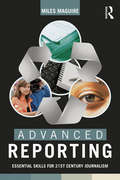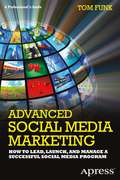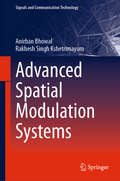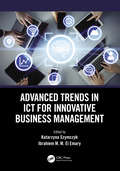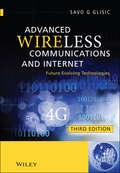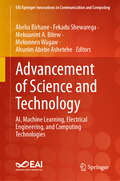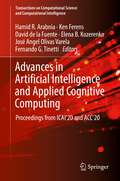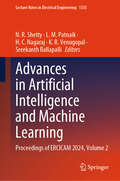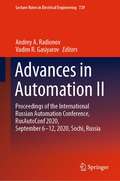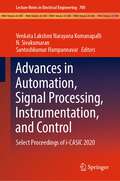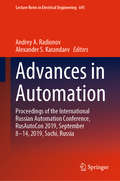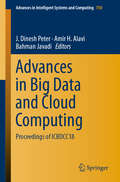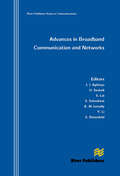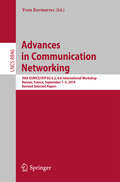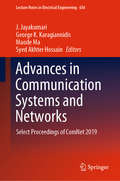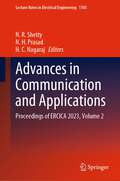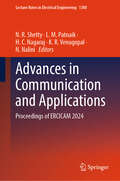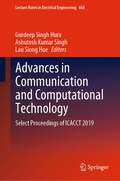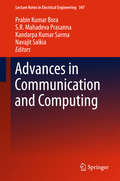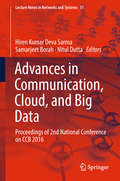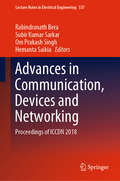- Table View
- List View
Advanced Reporting: Essential Skills for 21st Century Journalism
by Miles MaguireNews gathering is a large, complicated and often messy task that has traditionally been viewed by journalists as irretrievably idiosyncratic, best learned through trial and error. Advanced Reporting takes the opposite approach, focusing on reporting as a process of triangulation based on three essential activities: analyzing documents, making observations and conducting interviews. In this readable book, veteran journalism professor Miles Maguire shows how the best reporters use these three tools in a way that allows them to cross-check and authenticate facts, to reduce or eliminate unsupportable allegations and to take readers and viewers to a deeper level of insight and understanding. This book will help to prepare students for a profession marked by increasing complexity and competition. To succeed in this environment, journalists must learn to make the most of digital media to intensify the impact of their work. At the same time, reporters must contend with a host of sophisticated public relations techniques while engaging with news audiences that no longer just consume journalism, but also collaborate in its creation. Discussion questions and exercises help students put theory into practice.
Advanced Social Media Marketing: How to Lead, Launch, and Manage a Successful Social Media Program
by Tom FunkThey are laborers, soldiers, refugees, and orphans. In areas of the world torn by poverty, disease, and war, millions of children are invisible victims, deprived of home, family, and basic human rights. Their chances for a stable adult life are extremely slim. The powerful interdisciplinary volume Vulnerable Children brings a global child-rights perspective to the lives of indigenous, refugee, and minority children in and from?crisis-prone regions. Focusing on self-determination, education, security, health, and related issues, an international panel of scholars examines the structural and political sources of children''s vulnerabilities and their effects on development. The book analyzes intervention programs currently in place and identifies challenges that must be met at both the community and larger policy levels. These chapters also go a long way to explain the often-blurred line between vulnerability and resilience. Included in the coverage: Dilemmas of rights-based approaches to child well-being in an African cultural context. Poverty and minority childrenOCOs education in the U. S. : case study of a Sudanese refugee family. The heterogeneity of young childrenOCOs experiences in Kenya and Brazil. A world tour of interventions for children of a parent with a psychiatric illness. An exploration of fosterage of Owambo orphans in Namibia. UNICEF in Colombia: defending and nurturing childhood in media, public, and policy discourses. Vulnerable Children is a must-have volume for researchers, graduate students, and clinicians/professionals/practitioners across a range of fields, including child and school psychology, social work, maternal and child health, developmental psychology, anthropology, sociology, social policy, and public health"
Advanced Spatial Modulation Systems (Signals and Communication Technology)
by Rakhesh Singh Kshetrimayum Anirban BhowalThis state-of-the-art book deals with advanced spatial modulation (ASM), which are a special class of recent Multiple-Input Multiple-Output MIMO techniques, for various applications like radio frequency (RF) based body area network (BAN) communication, free-space optical (FSO) communication, underwater optical wireless communication (UOWC) and hybrid FSO/RF communication. The performance analysis of such systems is achieved in terms of certain performance metrics and compared with other techniques available in the literature. Such SM based schemes can find its application in advanced 5G and 6G communications. The diagrams of the system models of the different schemes along with tables and examples will help readers get a clear understanding of this approach. This book elucidates required derivations, examples, and links various concepts related to this field so that readers can gain comprehensive knowledge. Pseudo codes or algorithms or MATLAB/MATHEMATICA programs are also provided so that readers can easily implement the concepts which they learn. This volume will be useful for students, researchers, and industry alike.
Advanced Technologies for Industrial Applications
by Rohit Thanki Purva JoshiThis book provides information on advanced communication technology used in Industry 4.0 and 5.0. The book covers a variety of technologies such as signal processing, system designing, computer vision, and artificial intelligence and explains their benefits, usage, and market values in Industry 4.0 and 5.0. The authors present technological tools for industrial applications and give examples of their usage of system design, modeling, artificial intelligence, internet of things and robotics. This book covers the impact of these technologies in various industrial applications and provides future technological tools that will be helpful in future planning and development. The book is pertinent to researchers, academics, professionals, planners, and student’s interest in Industry 5.0.
Advanced Trends in ICT for Innovative Business Management
by Ibrahiem M. M. El Emary Katarzyna SzymczykThis book contains a collection of scientific chapters addressing the emerging trends in IT and telecommunications, as well as the issues that accompany them in business. It addresses issues in cyber applications, ICT solutions and innovative cyber know-how, and demonstrates how high-tech IT communications resources can be used to improve business production, sales and service strategies, supply chains and logistics. The book is based on articles from ICCMIT’20, extending their approach to specific chapters. The chapters cover issues such as financial management, technological upgrades, Industry 4.0 and the trend towards sustainable development. It utilizes examples of technologically advanced enterprises developing under Industry 4.0 assumptions at the stage of digital transformation, which integrate digital technologies and business processes. In addition, this book discusses issues related to cyber risk management and the implementation of a number of safeguards for digitized enterprises. Enterprises that orient themselves towards technological innovations find that they can reach customers faster, are more effectively managed and can achieve a competitive advantage over other businesses. This book will be a great aid to professionals in such companies, both in IT departments and in the management team.
Advanced Wireless Communications and Internet
by Savo G. GlisicThe new edition of Advanced Wireless Communications: 4G Cognitive and Cooperative Broadband Technology, 2nd Edition, including the latest developmentsIn the evolution of wireless communications, the dominant challenges are in the areas of networking and their integration with the Future Internet. Even the classical concept of cellular networks is changing and new technologies are evolving to replace it. To reflect these new trends,Advanced Wireless Communications & INTERNET builds upon the previous volumes, enhancing the existing chapters, and including a number of new topics. Systematically guiding readers from the fundamentals through to advanced areas, each chapter begins with an introductory explanation of the basic problems and solutions followed with an analytical treatment in greater detail.The most important aspects of new emerging technologies in wireless communications are comprehensively covered including: next generation Internet; cloud computing and network virtualization; economics of utility computing and wireless grids and clouds. This gives readers an essential understanding of the overall environment in which future wireless networks will be operating. Furthermore, a number of methodologies for maintaining the network connectivity, by using tools ranging from genetic algorithms to stochastic geometry and random graphs theory, and a discussion on percolation and connectivity, are also offered. The book includes a chapter on network formation games, covering the general models, knowledge based network formation games, and coalition games in wireless ad hoc networks.Illustrates points throughout using real-life case studies drawn from the author's extensive international experience in the field of telecommunicationsFully updated to include the latest developments, key topics covered include: Advanced routing and network coding; Network stability control; Relay-assisted Wireless Networks; Multicommodity flow optimization problems, flow optimization in heterogeneous networks, and dynamic resource allocation in computing cloudsMethodically guides readers through each topic from basic to advanced areasFocuses on system elements that provide adaptability and re-configurability, and discusses how these features can improve wireless communications system performance
Advanced Wireless Technologies for Industrial Network Systems (Wireless Networks)
by Xuemin Sherman Shen Nan Cheng Xinping Guan Ling LyuThis book provides a comprehensive overview of wireless technologies for industrial network systems. The authors first describe the concept of industrial network systems and their application to industrial automation. They then go on to cover the role of sensing and control in industrial network systems, and the challenge of sensing and control in the industrial wireless environment. Then, the existing techniques for resource efficiency information transmission are introduced and studied. Afterward, the authors introduce sensing and control-oriented transmission for industrial network systems, which take advantage of spatial diversity gain to overcome the interference and fading, which in turn improves the transmission reliability without expending extra spectrum resources and enlarging the transmission delay. Subsequently, edge assisted efficient transmission schemes are introduced, which integrate the capacities of communication, computing, and control to relieve the contradiction of resource limitation and massive data. Finally, the authors discuss open research issues and future works about information transmission in industrial network systems.
Advancement of Science and Technology: AI, Machine Learning, Electrical Engineering, and Computing Technologies (EAI/Springer Innovations in Communication and Computing)
by Mekuanint A. Bitew Abeba Birhane Fekadu Shewarega Mekonnen Wagaw Ahunim Abebe AsheteheThis proceeding presents the papers from the 11th International Conference on Advancement of Science and Technology (ICAST 2023), which took place in Bahir Dar, Ethiopia, in November 2023. The papers present economic and technologic developments in modern societies related to important issues such digitization, energy transformation, impact on national economy, and its recent advancements. The papers are relevant to researchers, academics, and professionals.
Advances and Applications in Computer Science, Electronics and Industrial Engineering: Proceedings of CSEI 2020 (Advances in Intelligent Systems and Computing #1307)
by Marcelo V. García Félix Fernández-Peña Carlos Gordón-GallegosThis book presents the proceedings of the Conference on Computer Science, Electronics and Industrial Engineering (CSEI 2020), held in Ambato in October 2020, with participants from 15 countries and guest speakers from Chile, Colombia, France, Japan, Spain, Portugal, and USA. It discusses topics such as the use of metaheuristic for non-deterministic problem solutions, software architectures for supporting e-government initiatives, and the use of electronics in e-learning and industrial environments. It also includes contributions illustrating how new approaches on these converging research areas are impacting the development of human societies around the world into Society 5.0. As such, it is a valuable resource for scholars and practitioners alike.
Advances in Artificial Intelligence and Applied Cognitive Computing: Proceedings from ICAI’20 and ACC’20 (Transactions on Computational Science and Computational Intelligence)
by Hamid R. Arabnia Fernando G. Tinetti Ken Ferens David de la Fuente Elena B. Kozerenko José Angel Olivas VarelaThe book presents the proceedings of two conferences: The 22nd International Conference on Artificial Intelligence (ICAI’20) and The 4th International Conference on Applied Cognitive Computing (ACC’20). The conferences took place in Las Vegas, NV, USA, July 27-30, 2020, and are part of the larger 2020 World Congress in Computer Science, Computer Engineering, & Applied Computing (CSCE'20), which features 20 major tracks. Topics include: deep learning; neural networks; brain models; cognitive science; natural language processing; fuzzy logic and soft computing (ICAI) and novel computationally intelligent algorithms; bio inspired cognitive algorithms; modeling human brain processing systems (ACC); and more. Authors include academics, researchers, and professionals.Presents the proceedings of two conferences as part of the 2020 World Congress in Computer Science, Computer Engineering, & Applied Computing (CSCE'20);Includes the tracks: artificial intelligence and applied cognitive computing;Features papers from the 22nd International Conference on AI (ICAI’20) and the 4th International Conference on Applied Cognitive Computing (ACC’20).
Advances in Artificial Intelligence and Machine Learning: Proceedings of ERCICAM 2024, Volume 2 (Lecture Notes in Electrical Engineering #1335)
by N. R. Shetty L. M. Patnaik H. C. Nagaraj K. R. Venugopal Sreekanth RallapalliThis book features papers from the International Conference on Emerging Research in Computing, Information, Communication, Artificial Intelligence, and Machine Learning (ERCICAM 2024). It serves as an interdisciplinary platform for researchers, professional engineers, scientists, educators, and technologists to discuss, debate, and promote advancements in research and technology within the evolving fields of computing, information, communication, and their applications. Topics covered include the Internet of Things (IoT), wireless communications, image and video processing, parallel and distributed computing, and smart grid applications, among others. The book explores these emerging research areas and acts as a valuable resource for both researchers and practicing engineers.
Advances in Automation II: Proceedings of the International Russian Automation Conference, RusAutoConf2020, September 6-12, 2020, Sochi, Russia (Lecture Notes in Electrical Engineering #729)
by Andrey A. Radionov Vadim R. GasiyarovThis book reports on innovative research and developments in automation. Spanning a wide range of disciplines, including communication engineering, power engineering, control engineering, instrumentation, signal processing and cybersecurity, it focuses on methods and findings aimed at improving the control and monitoring of industrial and manufacturing processes as well as safety. Based on the International Russian Automation Conference, held on September 6–12, 2020, in Sochi, Russia, the book provides academics and professionals with a timely overview of and extensive information on the state of the art in the field of automation and control systems, and fosters new ideas and collaborations between groups in different countries.
Advances in Automation, Signal Processing, Instrumentation, and Control: Select Proceedings of i-CASIC 2020 (Lecture Notes in Electrical Engineering #700)
by Venkata Lakshmi Narayana Komanapalli N. Sivakumaran Santoshkumar HampannavarThis book presents the select proceedings of the International Conference on Automation, Signal Processing, Instrumentation and Control (i-CASIC) 2020. The book mainly focuses on emerging technologies in electrical systems, IoT-based instrumentation, advanced industrial automation, and advanced image and signal processing. It also includes studies on the analysis, design and implementation of instrumentation systems, and high-accuracy and energy-efficient controllers. The contents of this book will be useful for beginners, researchers as well as professionals interested in instrumentation and control, and other allied fields.
Advances in Automation: Proceedings of the International Russian Automation Conference, RusAutoCon 2019, September 8-14, 2019, Sochi, Russia (Lecture Notes in Electrical Engineering #641)
by Andrey A. Radionov Alexander S. KarandaevThis book reports on innovative research and developments in automation.The chapters spans a wide range of disciplines, including communication engineering, power engineering, control engineering, instrumentation,signal processing and cybersecurity. Emphasis is given to methods and findings aimed at fostering better control and monitoring of industrial and manufacturing processes, and improving safety. Based on the International Russian Automation Conference, held in September 8-14, 2019, in Sochi,Russia, the book provides academics and professionals with a timely overview and extensive information on the state of the art in the field of automation and control systems, and is expected to foster new idea, as well as collaboration between different groups in different countries.
Advances in Big Data and Cloud Computing: Proceedings Of Icbdcc18 (Advances In Intelligent Systems and Computing #750)
by J. Dinesh Peter Amir H. Alavi Bahman JavadiThis book is a compendium of the proceedings of the International Conference on Big Data and Cloud Computing. It includes recent advances in the areas of big data analytics, cloud computing, internet of nano things, cloud security, data analytics in the cloud, smart cities and grids, etc. This volume primarily focuses on the application of the knowledge that promotes ideas for solving the problems of the society through cutting-edge technologies. The articles featured in this proceeding provide novel ideas that contribute to the growth of world class research and development. The contents of this volume will be of interest to researchers and professionals alike.
Advances in Blockchain Technology for Cyber Physical Systems (Internet of Things)
by Yassine Maleh Lo’ai Tawalbeh Saad Motahhir Abdelhakim Senhaji HafidThe Cyber-Physical System (CPS) relates to many other popularized technologies such as Internet of Things (IoT, IIoT), Machine-to-Machine (M2M), Industry 4.0, which describe a vision of connected creations that deeply unite the physical and information domains. As a revolutionary technology, Blockchain (BC) provides a practical solution to enable a secure and decentralized public ledger that a huge plethora of exciting new technology applications in several areas, such as the Internet of Things (IoT), Cyber-Physical Systems, Manufacturing, Supply-Chain, etc. Blockchain technology has infiltrated all areas of our lives, from manufacturing to healthcare and beyond. In this context, this book helps discover the various potential applications that could be fruitful for cyber-physical system applications. It provides a sampling of recent advances and ideas on research progress and the practical usage of blockchain technologies in addressing cyber-physical systems challenges and issues. It provides a sampling of recent advances and views on research progress and the practical usage of blockchain technologies in addressing cyber-physical systems challenges and issues.
Advances in Broadband Communication and Networks
by David Johnson David Burton Li Li Homayoun Nikookar Mark Bishop Peter Fischer Evangelos Bekiaris F. Zhang Ming Xu R. J. Evans C. Lin Z. Liu Thomas Magedanz Y. Li J. I. Agbinya O. Sevimli S. Lal S. Selvadurai A. Al-Jumaily S. Reisenfeld Graham I Hooker Ross Hennessey Craig Lobsey Andrew Maclean Andrew D. Hellicar Kieran Greene Greg Hislop Stephen Hanham Nasiha Nikolic Jia Dn Greg P. Timms John D. Bnnton Michael L. Brothers John W. Archer Val Dyadyuka Leigh Stokes B. Yang Y. Mo B. Wicks C. Ta-Minh G. Felic K. Wang P. Nadagonda T. Walsh E. Skafidas Kuan Lun Huang Jinhong Yuan Hajime Suzukia Iain B. Collings George Lam Mark Hedley Jian Andrew Zhang Eu-Suk Shim Jee-Hyun Kim Hyoung-Kyu Song Young-Hwan You J. Renato Nascimento Marius Iulian Corici Fabricio Carvalho de Gouveia Yaw Nkansah-Gyekye Eugene Zilberg Murad Karrar Saroj Lal Budi Thomas Jap Sara Lal Frank Chiang Robin Braun Bashar Ramadanny Ibrahim S. Raada Xiaojing Huang Raad RaadBroadband communications has become the major focus for industry for offering rich multimedia IP services in next generation networks. This book deals with the state-of-the-art and the underlying principles of key technologies which facilitate broadband telecommunications including millimetre wave gigabit Ethernet, terahertz communication, multiple input multiple output (MIMO) technology, orthogonal frequency division multiplex (OFDM), ultra wideband (UWB) and the fourth generation (4G) network technologies. The book illustrates the use of these technologies, including high resolution three-dimensional millimetre wave radar imaging and terahertz imaging techniques. Within the next few years advances in graphic rendering and the application of millimetre wave radar technology will enable high resolution radar surveillance and operators of industrial processes to control their machines and to navigate remotely even in poor visibility environments. The principles and performance of terahertz imaging are also demonstrated in this important book. The performance and success of emerging all-IP networks depend largely on the efficiency of broadband technologies and this book provides the basis for 4G networks and explores key performance measures such as quality of service and handover between distributed networks (mobile and fixed). The book also demonstrates the medical and biomedical applications of broadband wireless communications.
Advances in Communication Networking: 20th EUNICE/IFIP EG 6.2, 6.6 International Workshop, Rennes, France, September 1-5, 2014, Revised Selected Papers (Lecture Notes in Computer Science #8846)
by Yvon KermarrecThis book constitutes the refereed proceedings of the 20th EUNICE/IFIP WG 6. 2, 6. 6 Workshop on Advances in Communication Networking, EUNICE 2014, held in Rennes, France, in September 2014. The 21 papers presented were carefully reviewed and selected from numerous submissions and present aspects in the field of information and communication technologies.
Advances in Communication Systems and Networks: Select Proceedings of ComNet 2019 (Lecture Notes in Electrical Engineering #656)
by Maode Ma George K. Karagiannidis J. Jayakumari Syed Akhter HossainThis book presents the selected peer-reviewed papers from the International Conference on Communication Systems and Networks (ComNet) 2019. Highlighting the latest findings, ideas, developments and applications in all areas of advanced communication systems and networking, it covers a variety of topics, including next-generation wireless technologies such as 5G, new hardware platforms, antenna design, applications of artificial intelligence (AI), signal processing and optimization techniques. Given its scope, this book can be useful for beginners, researchers and professionals working in wireless communication and networks, and other allied fields.
Advances in Communication and Applications: Proceedings of ERCICA 2023, Volume 2 (Lecture Notes in Electrical Engineering #1105)
by N. R. Shetty N. H. Prasad H. C. NagarajThis book presents the proceedings of the International Conference on Emerging Research in Computing, Information, Communication and Applications (ERCICA) 2023. The conference provides an interdisciplinary forum for researchers, professional engineers and scientists, educators and technologists to discuss, debate and promote research and technology in the upcoming areas of computing, information, communication and their applications. Some of the topics include the Internet of Things (IoT), wireless communications, image and video processing, parallel and distributed computing, and smart grid applications, among others. The book discusses these emerging research areas, providing a valuable resource for researchers and practicing engineers alike.
Advances in Communication and Applications: Proceedings of ERCICAM 2024 (Lecture Notes in Electrical Engineering #1300)
by N. R. Shetty N. Nalini L. M. Patnaik H. C. Nagaraj K. R. VenugopalThis book presents the proceedings of the International Conference on Emerging Research in Computing, Information, Communication, Artificial Intelligence and Machine Learning (ERCICAM 2024). The book provides an interdisciplinary forum for researchers, professional engineers and scientists, educators and technologists to discuss, debate and promote research and technology in the upcoming areas of computing, information, communication and their applications. Some of the topics include the Internet of Things (IoT), wireless communications, image and video processing, parallel and distributed computing and smart grid applications, among others. The book discusses these emerging research areas, providing a valuable resource for researchers and practicing engineers.
Advances in Communication and Computational Technology: Select Proceedings of ICACCT 2019 (Lecture Notes in Electrical Engineering #668)
by Ashutosh Kumar Singh Gurdeep Singh Hura Lau Siong HoeThis book presents high-quality peer-reviewed papers from the International Conference on Advanced Communication and Computational Technology (ICACCT) 2019 held at the National Institute of Technology, Kurukshetra, India. The contents are broadly divided into four parts: (i) Advanced Computing, (ii) Communication and Networking, (iii) VLSI and Embedded Systems, and (iv) Optimization Techniques.The major focus is on emerging computing technologies and their applications in the domain of communication and networking. The book will prove useful for engineers and researchers working on physical, data link and transport layers of communication protocols. Also, this will be useful for industry professionals interested in manufacturing of communication devices, modems, routers etc. with enhanced computational and data handling capacities.
Advances in Communication and Computing (Lecture Notes in Electrical Engineering #347)
by Kandarpa Kumar Sarma Prabin Kumar Bora S. R. Mahadeva Prasanna Navajit SaikiaThe present volume is a compilation of research work in computation, communication, vision sciences, device design, fabrication, upcoming materials and related process design, etc. It is derived out of selected manuscripts submitted to the 2014 National Workshop on Advances in Communication and Computing (WACC 2014), Assam Engineering College, Guwahati, Assam, India which is emerging out to be a premier platform for discussion and dissemination of knowhow in this part of the world. The papers included in the volume are indicative of the recent thrust in computation, communications and emerging technologies. Certain recent advances in ZnO nanostructures for alternate energy generation provide emerging insights into an area that has promises for the energy sector including conservation and green technology. Similarly, scholarly contributions have focused on malware detection and related issues. Several contributions have focused on biomedical aspects including contributions related to cancer detection using active learning, application of clinical information in MECG using sample and channel convolution matrices for better diagnostic decision, etc. Some other works have focused on the DCT-domain linear regression of ECG signals, SVD Analysis on reduced 3-lead ECG data, the quantification of diagnostic information on ECG signal, a compressed sensing approach with application in MRI, learning aided image de-noising for medical applications, etc. Some works have dealt with application of audio fingerprinting for multi-lingual Indian song retrieval, semi-automatic approach to segmentation and the marking of pitch contours for prosodic analysis, semiautomatic syllable labeling for Assamese language, stressed speech recognition, handwriting recognition in Assamese script, speaker verification considering the effect of session variability and the block matching for motion estimation, etc. The primary objective of the present volume is to prepare a document for dissemination of and discussion on emerging areas of research in computation and communication as aimed by WACC 2014. We hope that the volume will serve as a reference book for researchers in these areas.
Advances in Communication, Cloud, and Big Data: Proceedings of 2nd National Conference on CCB 2016 (Lecture Notes in Networks and Systems #31)
by Hiren Kumar Sarma Samarjeet Borah Nitul DuttaThis book is an outcome of the second national conference on Communication, Cloud and Big Data (CCB) held during November 10-11, 2016 at Sikkim Manipal Institute of Technology. The nineteen chapters of the book are some of the accepted papers of CCB 2016. These chapters have undergone review process and then subsequent series of improvements. The book contains chapters on various aspects of communication, computation, cloud and big data. Routing in wireless sensor networks, modulation techniques, spectrum hole sensing in cognitive radio networks, antenna design, network security, Quality of Service issues in routing, medium access control protocol for Internet of Things, and TCP performance over different routing protocols used in mobile ad-hoc networks are some of the topics discussed in different chapters of this book which fall under the domain of communication. Moreover, there are chapters in this book discussing topics like applications of geographic information systems, use of radar for road safety, image segmentation and digital media processing, web content management system, human computer interaction, and natural language processing in the context of Bodo language. These chapters may fall under broader domain of computation. Issues like robot navigation exploring cloud technology, and application of big data analytics in higher education are also discussed in two different chapters. These chapters fall under the domains of cloud and big data, respectively.
Advances in Communication, Devices and Networking: Proceedings of ICCDN 2018 (Lecture Notes in Electrical Engineering #537)
by Rabindranath Bera Subir Kumar Sarkar Om Prakash Singh Hemanta SaikiaThe book covers recent trends in the field of devices, wireless communication and networking. It presents the outcomes of the International Conference in Communication, Devices and Networking (ICCDN 2018), which was organized by the Department of Electronics and Communication Engineering, Sikkim Manipal Institute of Technology, Sikkim, India on 2–3 June, 2018. Gathering cutting-edge research papers prepared by researchers, engineers and industry professionals, it will help young and experienced scientists and developers alike to explore new perspectives, and offer them inspirations on addressing real-world problems in the field of electronics, communication, devices and networking.
